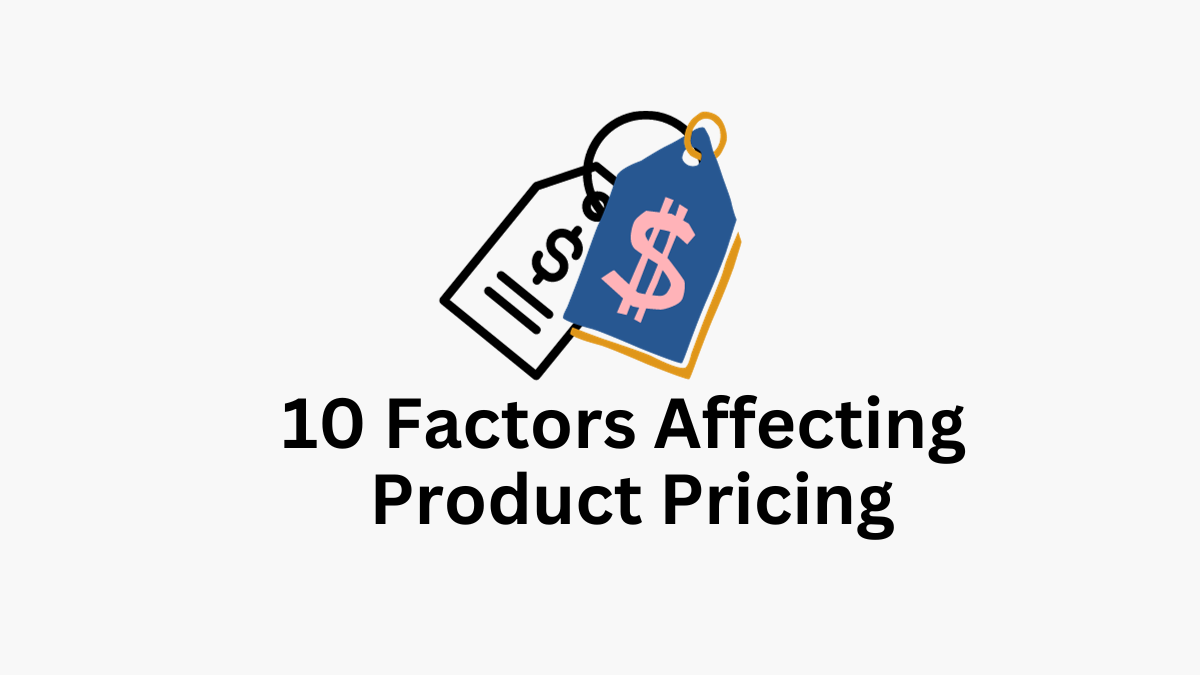Factors Affecting Product Pricing
While setting the price (value) of a product, businesses have to consider various factors before coming to a pricing decision. The following are 10 key factors that affect product pricing in business:
Costs
Costs play a pivotal role in pricing decisions. These are the expenses a business incurs to produce and offer a product. It includes both variable costs that change with production quantity (like raw materials and labor) and fixed costs that remain constant (like rent and salaries).
Pricing must ensure that these costs are covered while allowing for a profit. If costs increase, it might necessitate a price adjustment to maintain profitability.
Market Demand
Market demand represents how much customers are willing to buy a product at various prices. When demand is high, businesses can often charge higher prices. Conversely, during periods of lower demand, price reductions may be necessary to stimulate sales. Understanding and aligning pricing with market demand is crucial for optimizing revenue.
Competition
Competition in the market significantly influences pricing strategies. Businesses must analyze the pricing tactics of their competitors. If products are similar, competitive pricing may be necessary to stay in the game. However, if a product offers unique features or advantages, it can command higher prices. Pricing decisions are often made in consideration of how they stack up against rivals.
Perceived Value
How customers perceive a product’s value impacts their willingness to pay. Products that are seen as high-quality, innovative, or offering unique benefits can often bear higher price tags. On the other hand, products perceived as commodities may need to be competitively priced to attract buyers. Businesses must manage customer perceptions through pricing strategies.
Read More: 10 Importance of Pricing in Business
Economic Conditions
The broader economic landscape, including factors like inflation, interest rates, and overall consumer spending, can affect pricing. In economic downturns, customers may become more price-sensitive, prompting businesses to lower prices or offer discounts to maintain sales. During economic booms, consumers might be more willing to pay higher prices for products.
Product Life Cycle
The product life cycle also affects product pricing. PLC is like a journey that products take, from introduction to eventual retirement. At each stage – introduction, growth, maturity, and decline – the pricing strategy must adapt.
In the introduction phase, when a product is new, businesses might use skimming pricing to recover development costs quickly. During the growth phase, they could opt for penetration pricing to capture a larger market share. In maturity, competition may lead to competitive pricing, and as a product declines, discounting or discontinuation may be necessary.
Regulatory Environment
The regulatory environment refers to the laws and regulations governing industries and products. Government agencies set rules for product safety, labeling, and pricing practices. For example, pharmaceutical companies must adhere to strict pricing regulations, and the airline industry faces price transparency rules. Businesses must navigate this complex web of regulations to ensure compliance while devising pricing strategies.
Read More: Product Labelling – Definition
Brand Image
Brand image is the perception customers have of a brand. Strong brands can command higher prices, as they are associated with quality, trust, and prestige. Businesses invest in branding to create positive associations. Luxury brands, like Rolex or Louis Vuitton, have cultivated such strong brand images that they can set premium prices. Conversely, brands with a poor image might need to offer lower prices to attract customers.
Pricing Objectives
Pricing objectives are the goals a business aims to achieve through its pricing strategy. These objectives can vary, from maximizing profit to gaining market share, maintaining price stability, or positioning the product as a leader in quality. The chosen objective guides pricing decisions. If the goal is profit maximization, higher prices might be set. If it’s market share capture, competitive pricing could be the approach.
Consumer Behavior
Consumer behavior is the last in our list of 10 factors affecting pricing. It delves into how customers make purchasing decisions. It’s influenced by various factors, such as psychological triggers, social influences, and personal preferences.
Understanding consumer behavior helps businesses tailor pricing strategies. For instance, offering discounts to create a sense of urgency or employing psychological pricing (like $9.99 instead of $10) can nudge consumers to buy. Studying these behaviors is essential for effective pricing.
Read Next: Product Vs. Service: 10 Difference
Arti Kushmi holds a BBS (Bachelor in Business Studies) degree and shares her business and marketing knowledge through this website. While not writing she will be reading and enjoying the moment.
